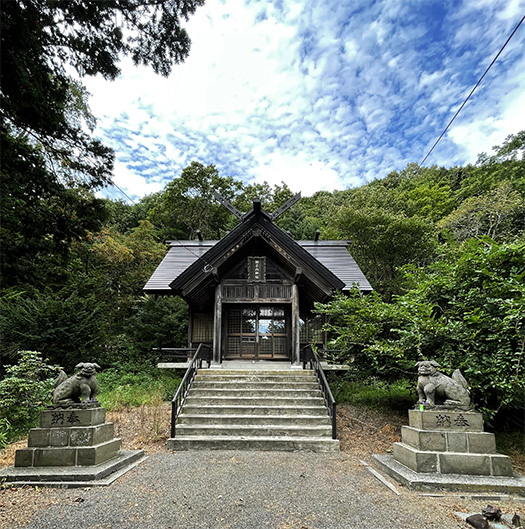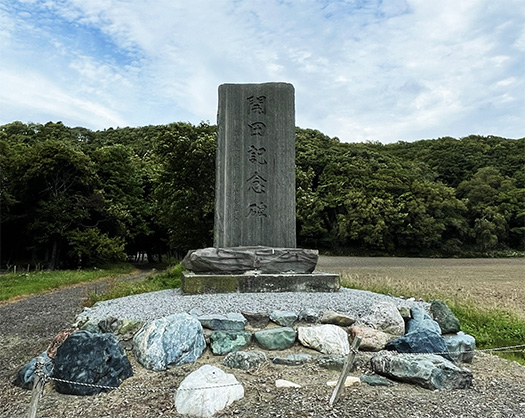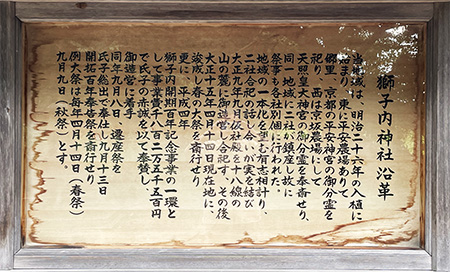


ここ3ヶ月ほど、関わっていた案件。整合性を持って進捗させるのがなかなかに困難だった件ですが、ようやく昨日、準備が完了して事態を一気に進捗させて、無事に一件落着させられました。
手探りであれやこれやの困難因子を特定させて、それへの事前対応をなるべくやり終えてから本番に着手するみたいな案件。で、胸の奥にわだかまっていたものがようやく氷解したような気分。まぁ、これからチェック作業があってそれへの対応などが必要にはなってきますが、それは通常的な「作業」ベースのこと。常識的に対応して、落とし所の見えていることがらになります。
ということで、久しぶりに「平常心」を復活させられる転換点。
人によってそれぞれ、そういう気分の回復の仕方は違いがあるでしょうが、わたしのきのうの心境としては札幌市近郊までクルマを走らせて北海道の晩夏〜初秋の天地の様子を目に飛び込ませて、脳味噌に視覚的刺激をあたえて、こころを放浪させることにしました。
そういういっときのあと、ふと道路脇に鄙びた神社が目に止まった次第。夢遊病者のように(笑)導かれて、その参道を本殿に向かっていた。
北海道は150年ほどの開拓歴史の地域なので、当別町にあるこちらの「獅子内神社」も明治26年というからいまから130年前に入植されたひとびとの「鎮守」として創建された。京都地方から入植の人びとだったようで、平安神宮の分霊を祀ったのだということ。
北海道内の神社って、そういえばあんまり巡ったことがないことに突然気付かされた。たしかに北海道には日本人社会としての積層した歴史はないのだけれど、このように「出自の地」の地神との関係性はあるので、そう考えれば、非常に「多様すぎる」民俗がそこに反映されているのだと気付かされた。
だいたい「平安神宮」という神社は、1895年に遷都1100年を記念して桓武天皇と孝明天皇を祭神とし創建された神社なので、ちょっと真空感がある。たぶん明治の初年の東京遷都への京都社会の反発をなだめるような政治的配慮で創建されたように思える存在。その神社を「祖霊」と考えてはるかな遠隔地・北海道にまで移住してきた人びとの心情に興味を抱かされる。
いまは当別市街から石狩市に通じる「岩見沢石狩線」に面して、山地を背にして建っている。立派な「開田祈念碑」が建てられている。北海道内でも稲作に適している地域としての認識があったのだろう。いまでも「当別米」という名称は記憶にある。
ということで、神前でややこころが静かになって参拝させていただきました。拝礼。
English version⬇
After all the trouble is over, you can find peace of mind at a quiet shrine.
I visited a shrine in the pioneer area around Sapporo, which had a tranquil atmosphere that guided me to the shrine. I was led to the shrines in the pioneer area around Sapporo, where there was a sense of tranquility. The shrine is located in the pioneer area around Sapporo.
This is a project that I have been involved in for the past three months. It has been quite difficult to make progress with consistency, but finally, yesterday, we were able to complete preparations and bring the situation to a successful conclusion.
It was a case in which we had to identify the factors that were causing difficulties, and then we had to deal with them in advance as much as possible before we could start the actual work. So, I feel as if something that has been nagging at the back of my mind has finally been cleared up. Well, there will be some checking work to be done, and we will need to respond to that, but that is normal “work. But it will be a normal “work” based thing, and it will be something that can be handled with common sense and a clear view of where to drop it.
So, this is a turning point where “normalcy” can be restored after a long time.
I know that everyone has their own way of recovering from this kind of mood, but yesterday I decided to drive to the outskirts of Sapporo and let my mind wander by visually stimulating my brain with the scenery of Hokkaido in late summer and early autumn.
After such a short time, a remote shrine suddenly caught my eye on the side of the road. Like a sleepwalker (laugh), I was led down the approach to the main shrine.
Hokkaido has a history of 150 years of pioneering, and Shishinai Shrine in Tobetsu-cho was built 130 years ago in 1893 as a Shinto shrine for the people who settled in the area. It seems that the settlers came from the Kyoto area and enshrined a branch spirit of Heian Shrine.
Suddenly I realized that I had not visited many shrines in Hokkaido. It is true that Hokkaido does not have a storied history as a Japanese society, but it does have a relationship with the local deity of its “place of origin,” so I realized that it reflects a very “diverse” folklore.
In general, the shrine called “Heian Jingu” was built in 1895 to commemorate the 1,100th anniversary of the relocation of the capital to Tokyo, and was dedicated to Emperor Kanmu and Emperor Komei, so it is a bit of a vacuum. It seems that the shrine was built as a political consideration to appease the opposition of Kyoto society to the relocation of the capital to Tokyo at the beginning of the Meiji era. It is interesting to learn the sentiments of the people who considered the shrine to be an “ancestral spirit” and migrated to the far remote island of Hokkaido.
Today, the shrine stands against the mountains on the Iwamizawa-Ishikari Line, which runs from Tobetsu City to Ishikari City. A magnificent monument stands in honor of the opening of the rice paddies. The area was recognized as one of the best areas in Hokkaido for rice cultivation. The name “Tobetsu Rice” is still remembered today.
So, I prayed in front of the god in a somewhat quiet state of mind. I bowed my head in worship.
Posted on 9月 6th, 2024 by 三木 奎吾
Filed under: 日本社会・文化研究







コメントを投稿
「※誹謗中傷や、悪意のある書き込み、営利目的などのコメントを防ぐために、投稿された全てのコメントは一時的に保留されますのでご了承ください。」
You must be logged in to post a comment.